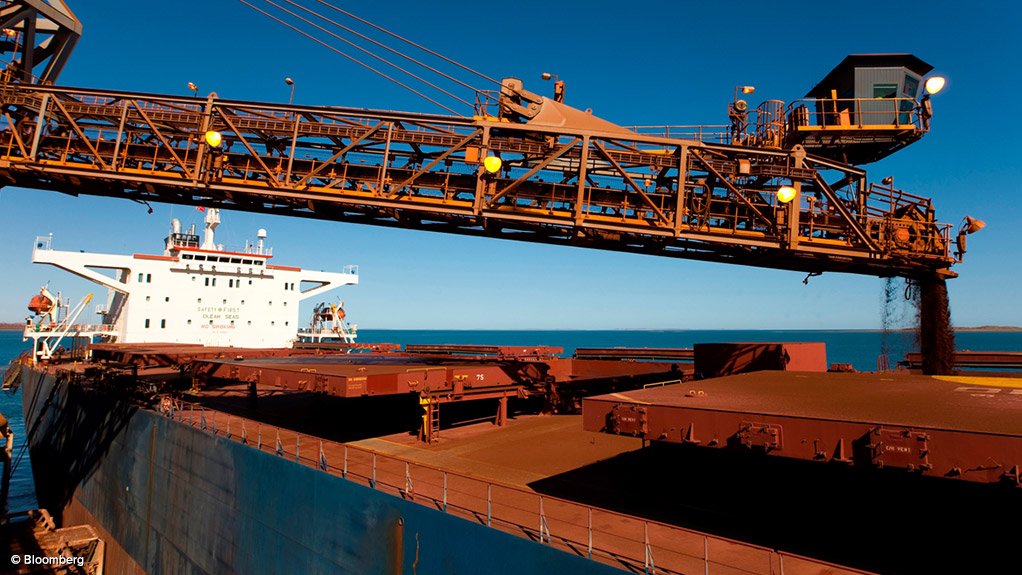Australian resource exports poised to fall
PERTH (miningweekly.com) – Australia’s commodity export earnings are forecast to fall from last year’s record A$467-billion to A$400-billion in 2023/24, and A$352-billion by 2024/25, the Department of Industry, Science and Resources said this week.
In the September edition of the Resources and Energy Quarterly (REQ), the Department noted that the global economic slowdown, including the sluggish rebound in the Chinese economy from Covid lockdowns, would cut resource and energy export earnings.
The REQ noted that despite the end of Covid restrictions, structural and cyclical factors are causing China’s growth to remain relatively weak. A weaker outlook for China is weighing on demand and commodity prices.
Furthermore, global steel demand has continued to slow, driven by China’s ongoing property sector weakness, as well as lower demand from European manufacturing and construction.
Global steel producers are expected to face subdued demand and moderating prices over the rest of 2023, while weak residential construction and falling industrial output in advanced nations is likely to be only partly offset by growth in infrastructure and non-residential construction activity.
Australia's iron-ore export earnings are expected to decline from A$124-billion in 2022/23 to A$120-billion in 2023/24 and A$99-billion in 2024/25. This is driven by lower prices over the outlook period.
Australian iron-ore export volumes remain strong, with further greenfield supply from established and emerging producers expected to come online in the next few years.
Meanwhile, following the end of Chinese restrictions on Australian coal imports, Australian thermal coal exports to China have returned to previous levels. However, Australian metallurgical coal has struggled to regain Chinese market share, as new rail links have facilitated a recent surge of Mongolian metallurgical coal exports to China in the past year or so, and Russia has been able to divert some of its coal exports to China (and India) from the Western nations which have banned Russian exports, the REQ found.
Australia’s metallurgical coal exports are forecast to lift from an estimated 157-million tonnes in 2022/23 to 172-million tonnes in 2024/25, as several new mines open. However, as prices decline, the value of Australia’s metallurgical coal exports is forecast to fall from A$62-billion in 2022/23 to A$41-billion in 2024/25.
A gradual recovery from recent supply outages is expected to see Australian thermal coal exports rise from 182-million tonnes in 2022/23 to 203-million tonnes by 2024/25. As prices decline, export values are forecast to fall from a peak above A$65-billion in 2022/23 to around A$28-billion by 2024/25.
Meanwhile, Australian gold production decreased to 149 t in the first half of 2023, owing to disruption from heavy rainfall. Production is forecast to increase with new projects and expansions. Gold earnings are forecast to decrease from A$24-billion in 2022/23 to around A$22-billion in 2024/25, as lower prices outweigh higher volumes.
Global copper consumption is expected to grow by 2.8% in 2023. China is expected to account for the bulk of this growth, with other major markets expected to see low growth or modest declines, the REQ stated.
Australian copper export earnings are forecast to reach around A$12.5-billion in 2023/24. Higher Australian production and export volumes will see export earnings reach A$12.8-billion in 2024/25.
Meanwhile, an oversupply in the global nickel market is expected to persist over the outlook period, driven by growth in Indonesian, and some Chinese mined and refined production. The REQ noted that the existing oversupply in Class II nickel, which is primarily used for stainless steel, is also expected to spill over into the battery grade nickel market over the outlook period.
Weaker prices over the outlook period are expected to see Australia’s nickel export earnings fall from A$5-billion in 2022/23 to A$4.3-billion in 2023/24. New production capacity in Australia is then expected to see a rebound in forecast earnings to A$4.5-billion in 2024/25.
Record Australian lithium exports, which reached A$20-billion in 2022/23, are forecast to decrease over the outlook period, as lower prices offset higher export volumes, with exports set to reach A$16-billion in 2024/25.
Lithium prices are expected to fall owing to the lithium market entering a sustained period of surplus supply, but remain well above levels prior to 2021.
The REQ noted that Australian lithium mine production continues growing owing to expansions and new mines, with Australia accounting for half of global lithium extraction and rising production meeting growing global battery demand for lithium.
Furthermore, Australia is developing capacity to refine lithium domestically, with three lithium hydroxide refineries either operating or under construction, and a newly announced lithium phosphate refinery. This contributes to diversifying global lithium refining and developing Australia’s battery value chain.
The REQ noted that revenue across the global battery value chain is projected to increase five-fold by 2030, with around 90% of the revenue opportunities occurring downstream of the mining stage.
The report stated that the current global battery supply chain remains very highly concentrated geographically. Particular stages of the value chain, such as cell manufacturing and pack assembly, are expected to diversify in coming years. However, under current policy settings, other stages such as crucial active material battery components are projected to remain heavily concentrated, predominantly in China, to 2030.
The REQ noted that Australia is a leading global source of battery raw materials such as cobalt, copper, lithium and nickel. However, there is an opportunity for Australia to move downstream in the battery value chain.
Meanwhile, Australia’s liquefied natural gas (LNG) export revenues hit a record high of A$93-billion in 2022/23 but are forecast to ease to A$71-billion in 2023/24 as the spike in global energy prices set off by the Russia/Ukraine war unwinds.
Asian LNG spot prices stabilised at around $12/million British thermal units (MMBtu) over the September quarter as European storage inventories neared capacity. Volatility increased marginally at the end of the quarter owing to industrial action at Australian export facilities.
Global LNG markets are likely to tighten over the December and March quarters as winter in the northern hemisphere raises gas demand for space heating.
Australia’s oil and gas industry body, Australian Energy Producers (EAP), said the strong future export earnings from LNG underscore the need for regulatory certainty in areas such as project approvals to encourage new gas supply.
“These strong forecasts are a reminder of the need for regulatory approval certainty so companies can invest in new gas supply and secure future economic benefits for Australia,” said EAP CEO Samantha McCulloch.
“LNG exports worth A$71-billion support thousands of jobs, flow through to Australian businesses via tens of billions in industry expenditure and deliver billions more to governments to help build hospitals and roads.
“But these benefits come after a long, high-risk and capital-intensive process needing regulatory certainty. Investment barriers, such as the growing uncertainty over vague regulations and the logjam of approvals with the national regulator, threaten this economic windfall for Australians.
“To continue to produce these results, Australia must ensure an approval means an approval. Reforms are desperately needed so Australia can avoid recent cases in which approvals for two major projects, Woodside Energy’s A$16.5-billion Scarborough development off Western Australia and Santos’ A$5.8-billion Barossa project off the Northern Territory, were overturned.”
McCulloch said there was increasing competition in global LNG markets and Australia must not miss the opportunity as Qatar and the US increased output and cemented their position in the gas market.
“Our LNG exports can also help importing nations lower emissions by switching to gas,” she said.
The REQ report found oil exports would hit A$15-billion this financial year, up from A$13-billion in 2022/23. They were expected to record A$12-billion in 2024/25.
Article Enquiry
Email Article
Save Article
Feedback
To advertise email advertising@creamermedia.co.za or click here
Press Office
Announcements
What's On
Subscribe to improve your user experience...
Option 1 (equivalent of R125 a month):
Receive a weekly copy of Creamer Media's Engineering News & Mining Weekly magazine
(print copy for those in South Africa and e-magazine for those outside of South Africa)
Receive daily email newsletters
Access to full search results
Access archive of magazine back copies
Access to Projects in Progress
Access to ONE Research Report of your choice in PDF format
Option 2 (equivalent of R375 a month):
All benefits from Option 1
PLUS
Access to Creamer Media's Research Channel Africa for ALL Research Reports, in PDF format, on various industrial and mining sectors
including Electricity; Water; Energy Transition; Hydrogen; Roads, Rail and Ports; Coal; Gold; Platinum; Battery Metals; etc.
Already a subscriber?
Forgotten your password?
Receive weekly copy of Creamer Media's Engineering News & Mining Weekly magazine (print copy for those in South Africa and e-magazine for those outside of South Africa)
➕
Recieve daily email newsletters
➕
Access to full search results
➕
Access archive of magazine back copies
➕
Access to Projects in Progress
➕
Access to ONE Research Report of your choice in PDF format
RESEARCH CHANNEL AFRICA
R4500 (equivalent of R375 a month)
SUBSCRIBEAll benefits from Option 1
➕
Access to Creamer Media's Research Channel Africa for ALL Research Reports on various industrial and mining sectors, in PDF format, including on:
Electricity
➕
Water
➕
Energy Transition
➕
Hydrogen
➕
Roads, Rail and Ports
➕
Coal
➕
Gold
➕
Platinum
➕
Battery Metals
➕
etc.
Receive all benefits from Option 1 or Option 2 delivered to numerous people at your company
➕
Multiple User names and Passwords for simultaneous log-ins
➕
Intranet integration access to all in your organisation




















